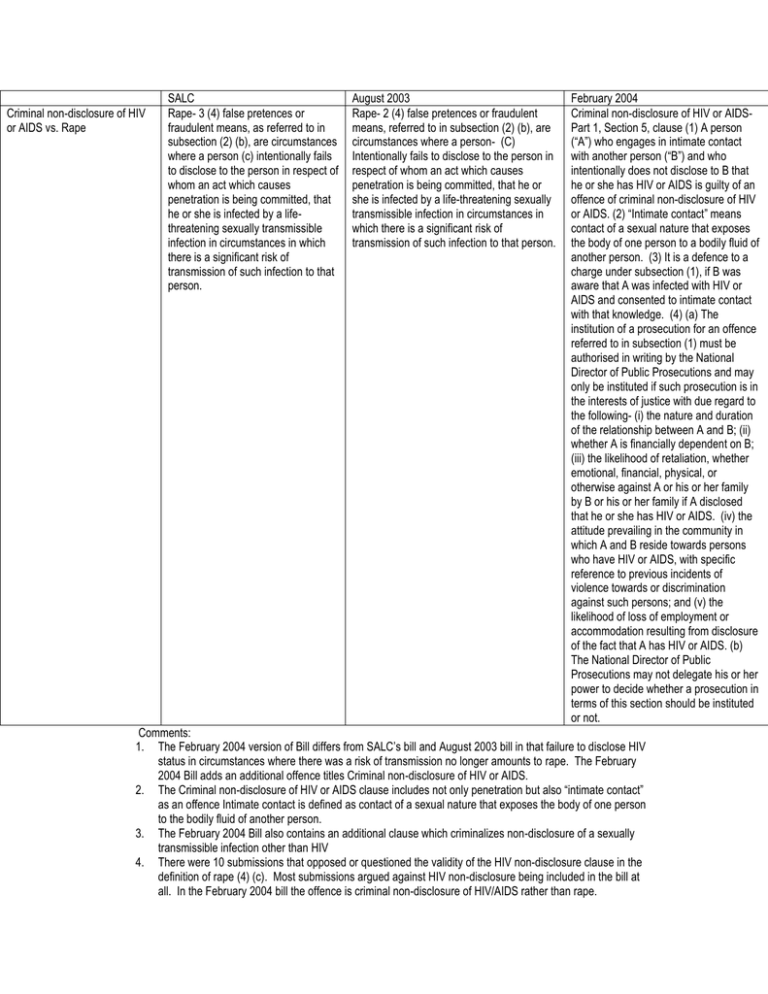
Criminal non-disclosure of HIV
or AIDS vs. Rape
SALC
Rape- 3 (4) false pretences or
fraudulent means, as referred to in
subsection (2) (b), are circumstances
where a person (c) intentionally fails
to disclose to the person in respect of
whom an act which causes
penetration is being committed, that
he or she is infected by a lifethreatening sexually transmissible
infection in circumstances in which
there is a significant risk of
transmission of such infection to that
person.
August 2003
Rape- 2 (4) false pretences or fraudulent
means, referred to in subsection (2) (b), are
circumstances where a person- (C)
Intentionally fails to disclose to the person in
respect of whom an act which causes
penetration is being committed, that he or
she is infected by a life-threatening sexually
transmissible infection in circumstances in
which there is a significant risk of
transmission of such infection to that person.
February 2004
Criminal non-disclosure of HIV or AIDSPart 1, Section 5, clause (1) A person
(“A”) who engages in intimate contact
with another person (“B”) and who
intentionally does not disclose to B that
he or she has HIV or AIDS is guilty of an
offence of criminal non-disclosure of HIV
or AIDS. (2) “Intimate contact” means
contact of a sexual nature that exposes
the body of one person to a bodily fluid of
another person. (3) It is a defence to a
charge under subsection (1), if B was
aware that A was infected with HIV or
AIDS and consented to intimate contact
with that knowledge. (4) (a) The
institution of a prosecution for an offence
referred to in subsection (1) must be
authorised in writing by the National
Director of Public Prosecutions and may
only be instituted if such prosecution is in
the interests of justice with due regard to
the following- (i) the nature and duration
of the relationship between A and B; (ii)
whether A is financially dependent on B;
(iii) the likelihood of retaliation, whether
emotional, financial, physical, or
otherwise against A or his or her family
by B or his or her family if A disclosed
that he or she has HIV or AIDS. (iv) the
attitude prevailing in the community in
which A and B reside towards persons
who have HIV or AIDS, with specific
reference to previous incidents of
violence towards or discrimination
against such persons; and (v) the
likelihood of loss of employment or
accommodation resulting from disclosure
of the fact that A has HIV or AIDS. (b)
The National Director of Public
Prosecutions may not delegate his or her
power to decide whether a prosecution in
terms of this section should be instituted
or not.
Comments:
1. The February 2004 version of Bill differs from SALC’s bill and August 2003 bill in that failure to disclose HIV
status in circumstances where there was a risk of transmission no longer amounts to rape. The February
2004 Bill adds an additional offence titles Criminal non-disclosure of HIV or AIDS.
2. The Criminal non-disclosure of HIV or AIDS clause includes not only penetration but also “intimate contact”
as an offence Intimate contact is defined as contact of a sexual nature that exposes the body of one person
to the bodily fluid of another person.
3. The February 2004 Bill also contains an additional clause which criminalizes non-disclosure of a sexually
transmissible infection other than HIV
4. There were 10 submissions that opposed or questioned the validity of the HIV non-disclosure clause in the
definition of rape (4) (c). Most submissions argued against HIV non-disclosure being included in the bill at
all. In the February 2004 bill the offence is criminal non-disclosure of HIV/AIDS rather than rape.
5.
4.
Women are more likely to be tested for HIV/AIDS. The effects of disclosing HIV status is more detrimental for
women then for men. Women frequently suffer abuse and abandonment after HIV status is disclosed to
partner.
Clause may lead to fewer people being tested.




